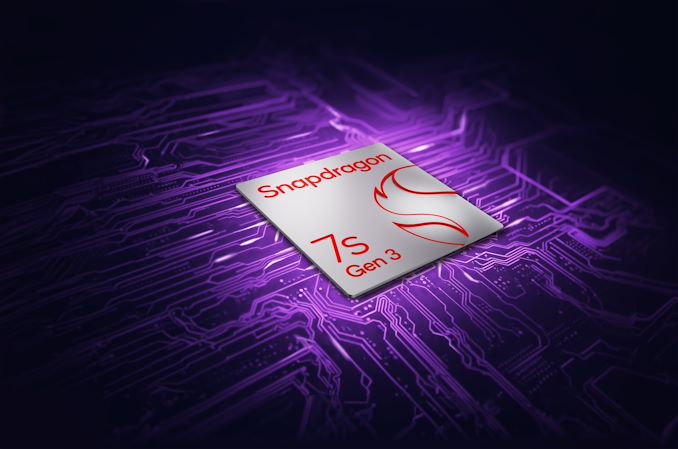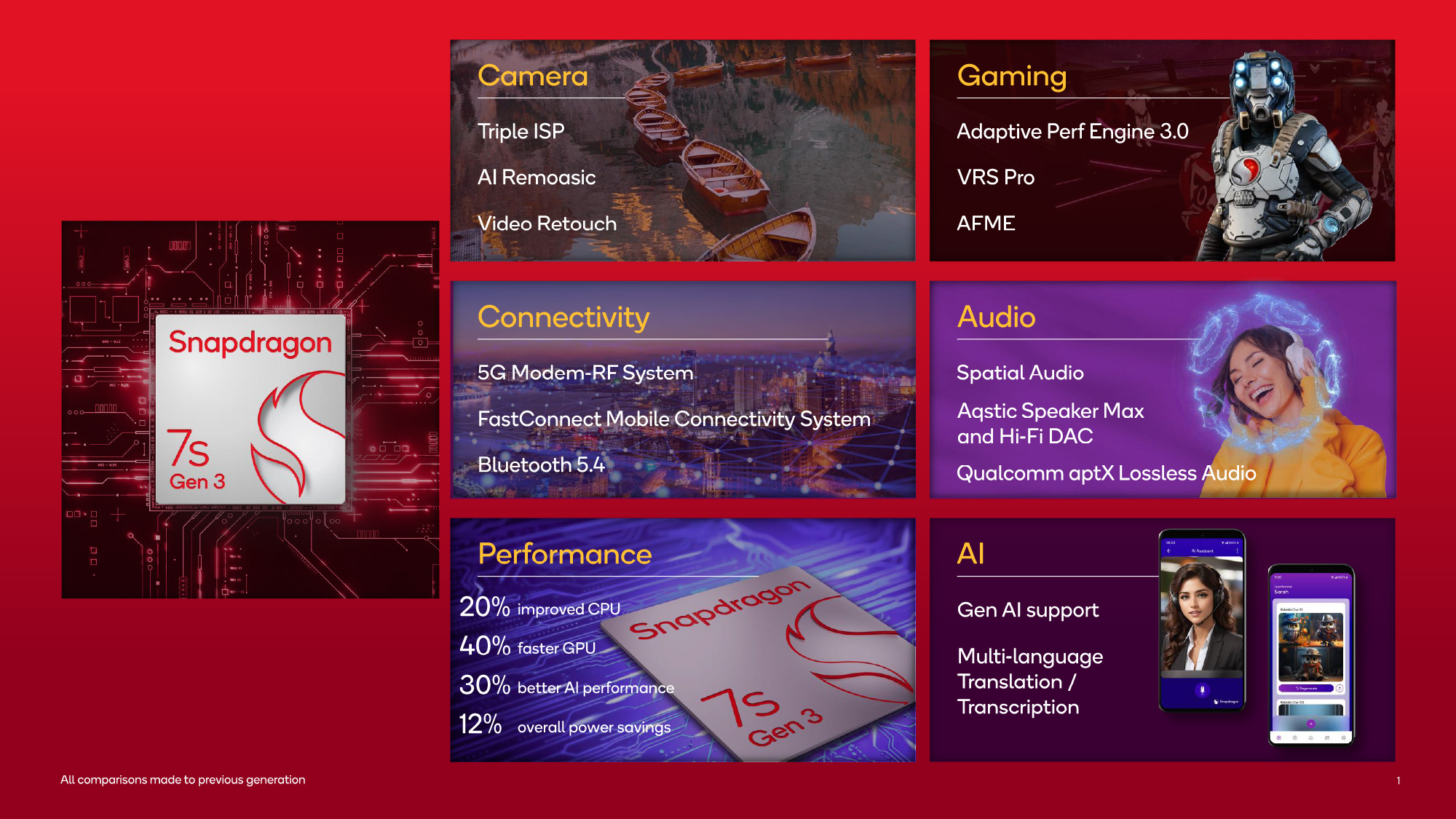Qualcomm this morning unveiled a new smartphone SoC for the mid-range market, the Snapdragon 7s Gen 3. This represents the second entry-level tier in Qualcomm’s ‘S’ series Snapdragon 7 parts, carved out for most Qualcomm-powered handsets in North America.
With three tiers of Snapdragon 7 chips, the 7s can easily be overshadowed by more powerful counterparts. However, the latest iteration stands out as Qualcomm has created a new die for this model. Consequently, the 7s family now incorporates Arm’s current Armv9 CPU cores, alongside various bits of Qualcomm’s latest IP elsewhere.
| Qualcomm Snapdragon 7-Class SoCs | ||||
| SoC | Snapdragon 7 Gen 3 (SM7550-AB) |
Snapdragon 7s Gen 3 (SM7635) |
Snapdragon 7s Gen 2 (SM7435-AB) |
|
| CPU | 1x Cortex-A715 @ 2.63GHz 3x Cortex-A715 4x Cortex-A510 |
1x Cortex-A720 @ 2.5GHz 3x Cortex-A720 4x Cortex-A520 |
4x Cortex-A78 @ 2.4GHz 4x Cortex-A55 |
|
| GPU | Adreno | Adreno | Adreno | |
| DSP / NPU | Hexagon | Hexagon | Hexagon | |
| Memory Controller |
2x 16-bit CH
@ 3200MHz LPDDR5 / 25.6GB/s @ 2133MHz LPDDR4X / 17.0GB/s |
2x 16-bit CH
@ 3200MHz LPDDR5 / 25.6GB/s @ 2133MHz LPDDR4X / 17.0GB/s |
2x 16-bit CH
@ 3200MHz LPDDR5 / 25.6GB/s @ 2133MHz LPDDR4X / 17.0GB/s |
|
| ISP/Camera | Triple 12-bit Spectra ISP
1x 200MP or 64MP with ZSL 4K HDR video & 64MP burst capture |
Triple 12-bit Spectra ISP
1x 200MP or 64MP with ZSL 4K HDR video & 64MP burst capture |
Triple 12-bit Spectra ISP
1x 200MP or 48MP with ZSL 4K HDR video & 48MP burst capture |
|
| Encode/ Decode |
4K60 10-bit H.265
H.265, VP9 Decoding Dolby Vision, HDR10+, HDR10, HLG 1080p120 SlowMo |
4K60 10-bit H.265
H.265, VP9 Decoding HDR10+, HDR10, HLG 1080p120 SlowMo |
4K60 10-bit H.265
H.265, VP9 Decoding HDR10, HLG 1080p120 SlowMo |
|
| Integrated Radio | FastConnect 6700 Wi-Fi 6E + BT 5.3 2×2 MIMO |
FastConnect Wi-Fi 6E + BT 5.4 2×2 MIMO |
FastConnect 6700 Wi-Fi 6E + BT 5.2 2×2 MIMO |
|
| Integrated Modem | X63 Integrated
(5G NR Sub-6 + mmWave) |
Integrated
(5G NR Sub-6 + mmWave) |
X62 Integrated
(5G NR Sub-6 + mmWave) |
|
| Mfc. Process | TSMC N4P | TSMC N4P | Samsung 4LPE | |
Officially, the Snapdragon 7s is classified as a 1+3+4 design – indicating a configuration of 1 prime core, 3 performance cores, and 4 efficiency cores. Qualcomm employs Arm’s current-generation Cortex-A720 cores for both prime and performance roles. The prime core can turbo up to 2.5GHz, while the performance cores can reach 2.4GHz.
These are complemented by 4 efficiency cores based on Arm’s A520, which can boost up to 1.8GHz.
Compared to the Snapdragon 7s Gen 2, this represents a considerable upgrade from the A78/A55 setup to the A720/A520 setup. Clock speeds remain similar to the previous generation, so any performance uplift is primarily driven by improvements in IPC, although the faster prime core does provide a boost for single-threaded workloads.
Overall, Qualcomm claims a 20% improvement in CPU performance over the 7s Gen 2, though it remains unclear whether this pertains to single or multi-threaded performance (or a combination of both).
The graphics are powered by one of Qualcomm’s Adreno GPUs. As usual, the specifics of the GPU configuration are undisclosed, without details on generation or significant differentiation from other Snapdragon 7 parts. While Qualcomm hasn’t introduced high-end features like ray tracing, there are indications that this may involve a next-generation (Adreno 800 series) design, though Qualcomm has not highlighted this.
Curiously, the video decode block on the SoC appears rather dated, lacking AV1 decoding and instead supporting H.265 and VP9 as the most advanced codecs.
Compared to CPU performance, the GPU performance gains are more pronounced. Qualcomm touts a 40% improvement in GPU performance over the 7s Gen 2.
Additionally, the Hexagon NPU block features some of Qualcomm’s latest IP, aligning with their AI-focused strategy across all chip segments. The version of the NPU used here introduces INT4 support for low-precision client inference, a first for the Snapdragon 7s family. As with other Gen 3 SoCs, the emphasis is on local (on-device) LLM execution.
In terms of performance, Qualcomm anticipates a 30% AI performance improvement compared to the 7s Gen 2.
Memory support remains consistent with the use of a 32-bit memory controller, supporting both LPDDR4X and LPDDR5. Memory bandwidth remains unchanged from the 7s Gen 2, offering up to 25.6GB/sec with LPDDR5-6400 and 17GB/sec with LPDDR4X-4266.
The Snapdrago 7s Gen 3 also incorporates enhanced camera hardware, maintaining triple 12-bit Spectra ISPs but increasing zero-shutter lag and burst mode resolution to 64MPix. Video recording capabilities remain similar, with continued support for 4K HDR capture.
In wireless communication, the 7s Gen 3 includes Qualcomm’s integrated Snapdragon 5G modem, supporting both Sub-6 and mmWave bands, with a theoretical maximum throughput of 2.9Gbps.
Interestingly, Qualcomm has moved away from specific modem versioning; the 7s Gen 3’s modem is simply labeled as an integrated Snapdragon modem. This change is part of an effort to “simplify overall branding and to be consistent with other IP blocks in the chipset.”
Likewise, the Wi-Fi/Bluetooth block is now referred to as a FastConnect block, featuring support for Wi-Fi 6E and Bluetooth 5.4.
The Snapdragon 7s Gen 3 is built on TSMC’s N4P process, marking Qualcomm’s transition of the Snapdragon 8 and 7 lines away from Samsung’s 4nm process nodes to TSMC. This shift is accompanied by a boost to power efficiency, with Qualcomm forecasting a 12% improvement in power savings.
Finally, Qualcomm’s launch partner for the Snapdragon 7s Gen 3 will be Xiaomi, set to introduce the first phone with this chip. Following Xiaomi, other manufacturers such as Realme and Sharp will adopt the chip, with Samsung also expected to incorporate it in future devices.




